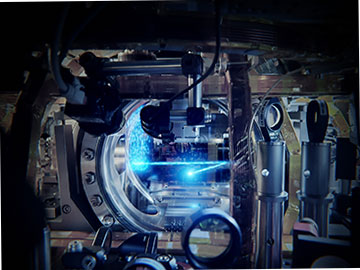
The central part of the Bose-Einstein condensate (BEC) demonstration in which coherent matter waves are created. New strontium atoms (blue) fall in and make their way to the BEC in the center. This image has been altered; in reality, the atoms are not visible to the naked eye. [Image: UvA/Image processing by Scixel]
Physicists based in the Netherlands designed and demonstrated a method for producing ultracold particles that could be used to provide a steady and sustainable flow of Bose-Einstein condensate (BEC) for an atom laser. A continuous-wave atom laser, analogous to a continuous-wave optical laser, would produce a coherent beam of matter instead of light (Nature, doi: 10.1038/s41586-022-04731-z).
The team’s new cooling method chills strontium atoms to almost absolute zero by moving them through consecutive cooling steps instead of gradually cooling the atoms over time in one place. Not only does this increase the chances of the atoms condensing into a coherent wave, but it also works as a sort-of BEC conveyer belt that could, in theory, be used to indefinitely power an atom laser.
The trouble with Bose-Einstein condensate
The key component of an atom laser is BEC, the fifth state of matter. BEC forms when a very diffuse gas is cooled, usually with lasers and evaporative cooling, to nearly absolute zero (about -273 °C). At this ultracold temperature, the atoms collectively fall into the lowest quantum state, condense into a coherent wave, and form BEC. This BEC can be extracted by an output coupler device to produce a beam of matter, much like coherent photons in a beam of laser light.
Unfortunately, the laser light used to cool atoms and create the condensate also quickly destroys it, thus limiting atom-laser output to very short pulses. To create a continuous-wave atom laser, the University of Amsterdam’s Florian Schreck and his team figured out a way to create a steady supply of BEC.
Replenishing BEC and future directions
To create a steady flow of BEC to fuel a continuous-wave atom laser, Schreck and his colleagues spread the laser cooling of strontium atoms not over time, but rather through space. “We make the atoms move while they progress through consecutive cooling steps,” Schreck explained in a press release. “In the end, ultracold atoms arrive at the heart of the experiment, where they can be used to form coherent matter waves in a BEC.” As the atoms are used and destroyed, a whole reservoir of newly cooling atoms is waiting right behind them to replenish the BEC.
The experimental setup to demonstrate the team’s method started with a stream of strontium atoms that was loaded into a crossed-beam dipole trap. The trap formed a reservoir where the atoms were laser-cooled. A “transparency” laser beam was applied to the reservoir, creating a light shift that made the strontium atoms transparent to the damaging light from the cooling lasers. The cooled atoms condensed into an ultracold gas dimple at the bottom of the reservoir and formed the BEC.
The physicists used atomic cloud density images to confirm that their technique did indeed create a continuous flow of BEC. They further validated these results by fitting the images to theoretical distributions. The team’s next steps include increasing BEC purity by enhancing the phase-space flux loading the dimple and lowering the reservoir temperature with Raman cooling.
